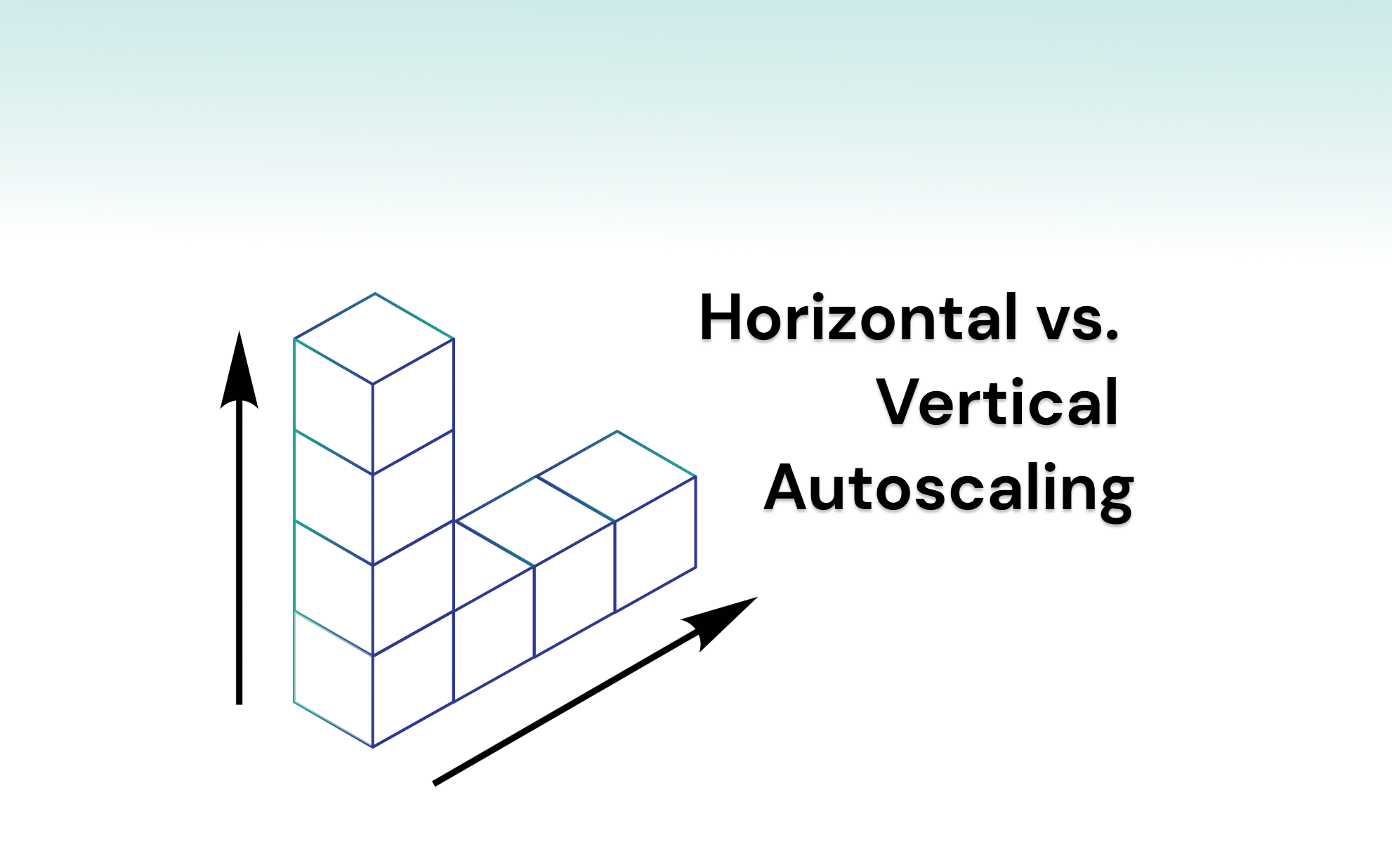Vertical vs horizontal scaling are two primary methods used in the tech industry for enhancing system capacity. These strategies are essential for businesses to understand as they develop systems capable of coping with growing demands without losing performance efficiency. Vertical scaling involves adding more power to existing hardware (RAM, CPU, GPU, and other resources), while horizontal scaling means expanding the system by adding more machines or nodes.
Generally, horizontal scaling is employed to manage rising traffic or workload volumes, whereas vertical scaling is often utilized for tasks or applications that are resource-heavy and demand greater processing power.
In this article, we will explore the differences between horizontal scaling and vertical scaling, discuss their respective advantages, and find out what the best solution is for your business.
What is Horizontal Scaling?
Horizontal scaling, also known as "scaling out", involves adding more machines or nodes to a system to handle increased traffic or workload. In other words, instead of relying on a single powerful machine, horizontal scaling distributes the workload across multiple machines.
Benefits of Horisontal Scaling
One of the main benefits of horizontal scaling is its ability to provide high availability and fault tolerance. By distributing the workload across multiple machines, even if one machine fails or goes offline, the system can still function properly using the remaining machines.
Additionally, horizontal scaling allows for easy and cost-effective scalability, as new machines can be added incrementally when needed.
Implementing Horizontal Scaling: Distributing Workload Across Multiple Systems
Let's dive deeper into the concept of horizontal scaling and explore its various aspects.
When it comes to horizontal scaling, the key idea is to distribute the workload across multiple machines. This distribution can be achieved through various techniques such as load balancing, sharding, or replication.
- Load balancing is a technique that evenly distributes incoming requests across multiple machines. It ensures that no single machine is overwhelmed with excessive traffic, thus improving the overall performance and responsiveness of the system. Load balancers can be implemented using hardware or software solutions, and they play a crucial role in horizontal scaling.
- Sharding is another technique used in horizontal scaling, particularly in distributed databases. It involves dividing the data into smaller subsets called shards and distributing them across multiple machines. Each machine is responsible for storing and processing a specific shard of data. This approach allows for parallel processing and improves the system's ability to handle large datasets and high traffic loads.
- Replication is yet another important aspect of horizontal scaling. It involves creating copies of data or services across multiple machines. These copies, also known as replicas, ensure that the system can continue to function even if one or more machines fail. Replication can be implemented at various levels, including database replication, file replication, or service replication.
In conclusion, horizontal scaling is a powerful technique that allows for the distribution of workload across multiple machines. It provides high availability, fault tolerance, and cost-effective scalability. Techniques such as load balancing, sharding, and replicationplay a crucial role in achieving horizontal scalability.
Now, let's learn about the concept of vertical scaling.
What is Vertical Scaling?
Vertical scaling, also known as "scaling up", involves increasing the resources of an individual machine to handle an increased workload. This typically involves upgrading the hardware components of a machine, such as its memory or processing power.
Benefits of Vertical Scaling
When it comes to vertical scaling, there are various ways to upgrade the hardware components of a machine.
- One common approach is to increase the memory capacity. This allows the machine to store and process larger amounts of data, which can be particularly useful for applications that require extensive data processing or analysis.
- Another aspect of vertical scaling involves upgrading the processing power of a machine. This can be done by replacing the existing processor with a more powerful one or by adding additional processors to the machine. With increased processing power, the machine can handle more complex tasks and calculations, resulting in improved performance and faster response times.
- In addition to memory and processing power, other hardware components can also be upgraded during vertical scaling. For example, upgrading the storage capacity of a machine can provide more space for storing data and files. This can be beneficial for applications that generate large amounts of data or require extensive storage capabilities.
Vertical scaling is often employed in scenarios where the workload of a single machine increases gradually over time. By upgrading the resources of the machine, it can continue to handle the growing workload without the need for additional machines or complex configurations.
Limitations of Vertical Scaling
However, vertical scaling does have its limitations. There is a maximum threshold to how much a machine can be upgraded before it reaches its hardware limitations. At this point, further vertical scaling becomes impractical or even impossible.
In such cases, alternative scaling strategies, such as horizontal scaling, may need to be considered.
In conclusion, vertical scaling is a method of increasing the resources of an individual machine to handle an increased workload. It involves upgrading the hardware components, such as memory and processing power, to improve performance and efficiency.
>> Want to automate your horistontal and vertical scaling? Learn how to implement autoscaling for optimal K8s performance.
Horizontal vs Vertical scaling:
Now that we have a clear understanding of the concepts of horizontal scaling vs. vertical scaling, let's build and and comprehensive comparison between the two scaling strategies.
Understanding the Differences between Horizontal Scaling and Vertical Scaling
Horizontal scaling is well-suited for distributed systems that can take advantage of parallel processing. It is particularly effective for applications that can be easily divided into smaller independent tasks that can be processed concurrently.
Examples of such applications include web servers, content delivery networks, and distributed databases.
For example, in a web server environment, horizontal scaling allows for the distribution of incoming requests across multiple servers, enabling better performance and fault tolerance. Each server can handle a portion of the workload, resulting in faster response times and increased availability.
On the other hand, vertical scaling is beneficial when the workload requires access to a large amount of shared resources, such as a centralized database. It is useful for applications that cannot be easily partitioned and require the entire dataset to be accessible on a single machine. Examples of such applications include traditional SQL databases and certain enterprise applications.
For instance, in a centralized database scenario, vertical scaling involves increasing the resources of a single machine, such as adding more memory or upgrading the CPU. This allows the database to handle larger datasets and complex queries without the need for data partitioning or distribution.
Learn the key strategies for scaling Kubernetes clusters, including Cluster autoscaling, horizontally scaling (HPA/Keda) and vertical scaling (VPA/Karpenter).
Horizontal vs Vertical Scaling: Making the Right Choice
Deciding whether to use horizontal scaling or vertical scaling depends on various factors, such as the nature of the workload, cost considerations, and the specific requirements of the system.
Let's take a closer look at the differences between these two approaches.
Firstly, the nature of the workload and the specific requirements of the system should be taken into account. For horizontal scaling, technologies such as load balancers, containerization, and microservices architectures can be beneficial.
For example, in a microservices architecture, horizontal scaling can be achieved by deploying multiple instances of individual microservices and using a load balancer to distribute incoming requests. This allows for better fault tolerance and scalability, as each microservice can be scaled independently.
For vertical scaling, technologies such as virtualization and cloud-based services can provide the necessary resources to enhance the performance of a single machine. It is essential to evaluate the cost implications, maintenance overhead, and compatibility with existing infrastructure when choosing the right technology for scaling.
For instance, in a cloud-based environment, vertical scaling can be achieved by utilizing the scalability features provided by the cloud provider, such as auto-scaling groups or instance resizing. This allows for dynamic resource allocation based on the workload, ensuring optimal performance and cost efficiency.
In conclusion, the choice between horizontal and vertical scaling depends on the specific requirements of the system, the nature of the workload, and the desired level of scalability. Both approaches have their own advantages and limitations, and it is important to carefully evaluate these factors before making a decision. Ultimately, a well-designed scalable system can ensure optimal performance and accommodate future growth effectively.
Scale automatically with PerfectScale

PerfectScale offers a comprehensive solution for organizations of all sizes to reduce cloud costs without sacrificing performance. Utilizing advanced algorithms and machine learning, it ensures services are optimally resourced to balance demand and cost. PerfectScale simplifies Kubernetes cost optimization by automatically right-sizing and scaling resources, adapting continuously to dynamic environments. This reduces waste and enhances system stability.
By handling Kubernetes cost optimization, PerfectScale frees DevOps, Platform, SRE, and FinOps teams to concentrate on more strategic projects. It assures ongoing optimal scaling of your K8s environment, resulting in lower cloud expenses, fewer SLA/SLO breaches, and reduced outages. Users experience enhanced reliability and stability.
Easy to implement, PerfectScale begins delivering immediate results. Schedule a demo today to see how it can help you cut Kubernetes costs while prioritizing system uptime and resilience.






.png)






